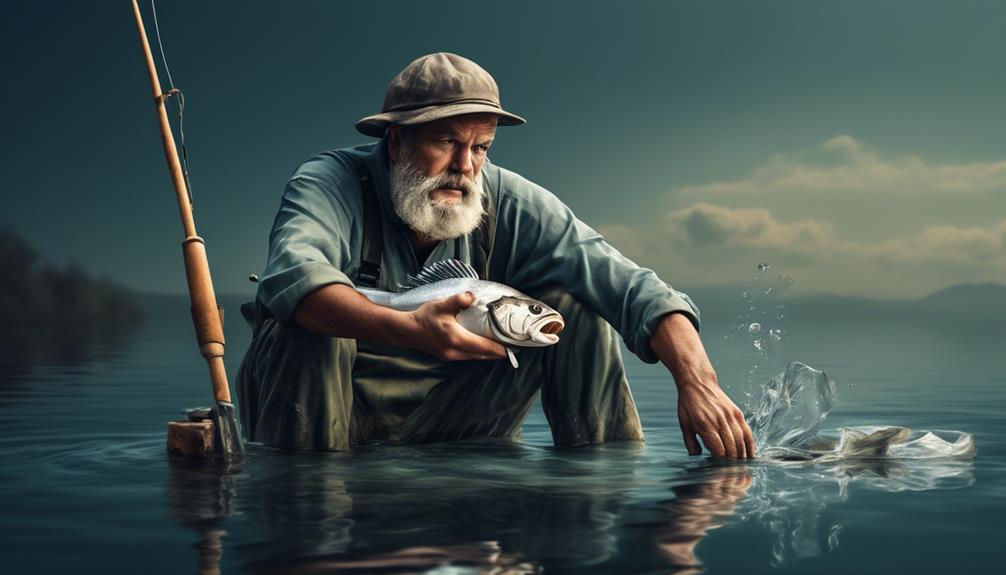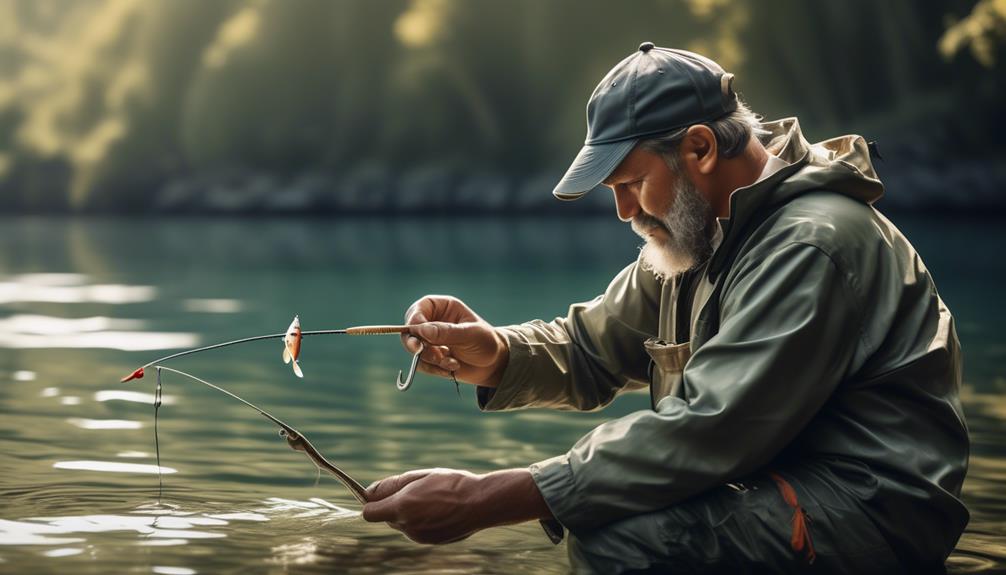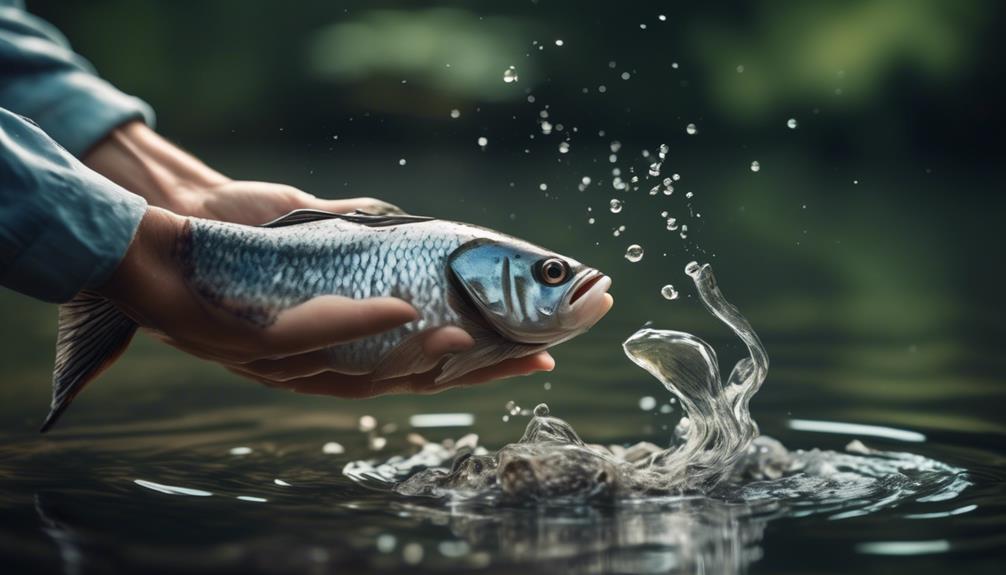Catch and release fishing presents a myriad of ethical considerations that often go unnoticed.
As an angler, you may be faced with dilemmas that require careful navigation to ensure the well-being of the fish population. From the unintended harm caused during the release process to the potential stress and injury inflicted on the fish, there are numerous factors to contemplate.
These dilemmas not only impact the individual fish but also have broader ecological implications that deserve thoughtful consideration.
Unintended Harm to Fish

When practicing catch and release fishing, it's important to be mindful of the potential unintended harm that can be caused to the fish. Ethical considerations come into play when engaging in this popular angling practice. While the intention is to conserve fish populations by releasing them back into their natural habitat, the process can still pose risks to the fish.
Conservation efforts are a fundamental aspect of catch and release fishing. The goal is to minimize the impact on fish populations and their ecosystems. Ethical anglers understand the importance of ensuring the well-being of the fish they catch and release. However, the process isn't without its challenges. The handling and hooking of fish, even when done carefully, can still result in injuries. It's crucial to be aware of the potential harm that can be inflicted during the catch and release process.
When it comes to ethical considerations, anglers should prioritize using barbless hooks and appropriate gear to minimize harm to the fish. Additionally, adopting proper fish handling techniques and being mindful of the duration of the fight can significantly reduce stress and injury to the fish. Furthermore, anglers should be well-informed about the best practices for catch and release fishing to ensure minimal impact on fish populations and their environment.
Stress and Injury to Fish
To ensure the well-being of the fish, prioritize using barbless hooks and appropriate gear to minimize stress and injury during catch and release fishing. Ethical considerations and conservation efforts should guide your actions when engaging in catch and release fishing.
Stress and injury to fish aren't only a matter of ethical considerations but also have significant moral implications and environmental impact. Here are some key points to consider:
- Barbless Hooks: Using barbless hooks can significantly reduce the damage to the fish's mouth and make it easier to release them without causing excessive harm. This simple adjustment to your gear can make a substantial difference in minimizing stress and injury to the fish.
- Proper Handling: Ensure that you handle the fish with care and minimize the time it spends out of the water. Keeping the fish in the water as much as possible and handling it gently can help reduce stress and increase its chances of survival after release.
- Appropriate Gear: Using the right gear for the size of fish you're targeting is crucial. Using heavy gear for small fish can cause unnecessary stress and injury, so adjusting your equipment to match the size of the fish is an important ethical consideration.
Misuse of Barbed Hooks
Using barbed hooks in a manner that causes unnecessary harm to the fish contradicts the ethical principles of catch and release fishing. When a fish is hooked with a barbed hook, the potential for tissue damage increases significantly. This can lead to a more traumatic hook removal process and can also result in a slower recovery for the fish post-release.
Proper hook removal is essential to minimizing harm to the fish. Misusing barbed hooks can make the removal process more difficult and can cause additional injury to the fish. Furthermore, the use of barbed hooks can make it more challenging to achieve a proper release. The barbs can cause more damage when the hook is being removed, which in turn can affect the fish's ability to survive after being released.
Therefore, it's crucial to handle fish with care and use barbless hooks whenever possible to minimize harm and maximize the chances of a successful release. By using barbless hooks and practicing proper catch and release techniques, you can help ensure the well-being of the fish population and contribute to the sustainability of the sport.
Inadequate Handling Techniques
Improper handling techniques can lead to unnecessary stress and injury to the fish during catch and release fishing. Proper fish handling is crucial to minimize harm and uphold ethical considerations. When engaging in catch and release fishing, it's essential to prioritize the well-being of the fish by employing appropriate handling techniques.
Here are some important considerations to keep in mind:
- Minimize Air Exposure: When a fish is brought to the surface, it can experience barotrauma due to the rapid pressure change. To prevent this, minimize air exposure by keeping the fish in the water as much as possible while unhooking and releasing it.
- Use of Barbed Hooks: If barbed hooks are used, it's imperative to handle the fish with extra care during hook removal to minimize tissue damage. Consider using barbless hooks to reduce injury and facilitate easier hook removal.
- Proper Support: When handling a fish, ensure that it's properly supported. Avoid gripping the fish tightly or holding it vertically by its jaw, as this can cause internal injuries or dislocate the jaw. Instead, cradle the fish gently and support its body to minimize stress and potential harm.
Adhering to proper fish handling techniques not only reduces the negative impact on the fish but also aligns with ethical considerations of catch and release fishing. By prioritizing the well-being of the fish through conscientious handling, anglers can contribute to the sustainability of fish populations and promote responsible fishing practices.
Impact on Fish Spawning Behavior
Impact on fish spawning behavior can be influenced by catch and release fishing practices, potentially affecting the reproductive success of fish populations. When fish are caught and released during their spawning season, it can lead to habitat disturbance and breeding disruption. The stress of being caught, handled, and released can cause fish to abandon their spawning sites or interrupt their courtship and mating behaviors, ultimately impacting population dynamics and reproductive success.
Habitat disturbance resulting from catch and release fishing can have detrimental effects on fish spawning behavior. Disturbances such as repeated angling pressure in spawning areas can lead to the trampling of redds (nests) and destruction of spawning habitats, reducing the chances of successful egg fertilization and hatching. Additionally, the physical handling of fish during catch and release can disrupt their natural spawning behaviors, potentially leading to decreased reproductive success.
Breeding disruption caused by catch and release fishing practices can further exacerbate the impact on fish spawning behavior. When fish are caught and released multiple times, it can lead to increased stress and energy depletion, affecting their ability to engage in courtship displays, locate suitable mates, and successfully fertilize eggs. These disruptions in mating behaviors can have profound effects on the overall reproductive success of fish populations, potentially leading to declines in recruitment and genetic diversity.
Use of Inappropriate Tackle
When selecting your fishing tackle, it's crucial to ensure that it's appropriate for the size and species of fish you're targeting. Using inappropriate tackle can lead to negative consequences for fish welfare and the environment. Here are a few key points to consider:
- Fish Welfare: Using tackle that's too heavy or not suited for the targeted fish can cause excessive stress and injury to the fish. For instance, using heavy tackle for smaller fish can result in extended fight times, causing exhaustion that may reduce the fish's chances of survival after release. Additionally, inappropriate tackle such as oversized hooks can cause unnecessary damage to the fish's mouth, making it harder for them to feed and increasing their vulnerability to predators.
- Environmental Impact: Inappropriate tackle can also have a detrimental impact on the environment. For example, using heavy line or leaders can increase the likelihood of break-offs, leaving behind abandoned fishing gear that can entangle and harm other wildlife. Additionally, using tackle that isn't properly matched to the targeted species can result in unintentional bycatch, potentially harming non-targeted species and disrupting the balance of the ecosystem.
It's essential to carefully consider the gear you use to ensure it aligns with ethical and sustainable fishing practices. By selecting the right tackle for the size and species of fish you're targeting, you can help minimize negative impacts on fish welfare and the environment.
Failure to Revive Exhausted Fish

Using inappropriate tackle may lead to exhausted fish, requiring careful revival techniques to ensure their survival. When fish are overexerted due to the use of inadequate tackle, they may struggle to recover even after being released. This can lead to fish mortality and goes against the principles of catch and release fishing. The exhaustion caused by inappropriate tackle can result in oxygen deprivation for the fish, which further exacerbates their struggle to survive.
Failure to properly revive exhausted fish can significantly increase their mortality rates. Oxygen deprivation during the fight and subsequent release can have lasting effects on the fish's health. It's crucial to handle exhausted fish with care and take the necessary steps to ensure their revival before releasing them back into the water.
To prevent fish mortality due to exhaustion, it's important for anglers to be equipped with the knowledge and skills to revive fish effectively. This includes gently cradling the fish in the water, moving it back and forth to pass water through its gills, and waiting until it shows signs of recovery before letting it swim away. By taking these measures, anglers can help mitigate the potential harm caused by oxygen deprivation and increase the chances of survival for exhausted fish.
Disregard for Protected Species
As an angler, it's essential to be mindful of protected species and adhere to regulations to ensure their conservation and sustainable management. Disregarding protected species poses a significant threat to their populations and undermines conservation efforts. When engaging in catch and release fishing, it's crucial to recognize the importance of preserving the delicate balance of aquatic ecosystems and respecting the legal framework in place to protect vulnerable species.
- Conservation Efforts: By disregarding protected species, you directly impede the conservation efforts aimed at maintaining biodiversity and ensuring the survival of vulnerable aquatic life. Your actions can have far-reaching implications for the overall health of aquatic ecosystems, disrupting the delicate balance that sustains diverse fish populations.
- Protected Species: Ignoring regulations and knowingly targeting protected species can lead to detrimental consequences for their populations. It's imperative to familiarize yourself with the list of protected species in your fishing area and take proactive measures to avoid harming them.
- Catch Limits and Fish Populations: Disregarding protected species can also impact catch limits and fish populations. Overexploitation of vulnerable species can lead to imbalances within the ecosystem, affecting the abundance of other fish species and compromising the overall sustainability of the aquatic environment.
Adhering to regulations and showing respect for protected species isn't only a legal obligation but a moral responsibility as an angler. Your conscientious actions contribute to the preservation of diverse aquatic life and the sustainability of fisheries for future generations.
Frequently Asked Questions
What Are the Potential Long-Term Effects of Catch and Release Fishing on Fish Populations?
Catch and release fishing can have potential long-term effects on fish populations. Stress from being caught can impact genetic diversity and increase mortality rates. This practice might lead to reduced reproductive success and overall fish population decline.
Additionally, high stress levels can weaken fish, making them more susceptible to predation and disease. It's important to consider the impact of catch and release fishing on fish populations and the ecosystem as a whole.
How Can Catch and Release Fishing Impact the Overall Ecosystem of a Body of Water?
Catch and release fishing can impact the overall ecosystem of a body of water in various ways. It can influence the biodiversity by affecting the abundance and distribution of fish species.
Additionally, it can impact ecosystem health by altering predator-prey dynamics and nutrient cycling. These changes may have cascading effects on other organisms within the ecosystem, potentially disrupting the delicate balance of the aquatic environment.
Are There Alternative Fishing Practices That Can Minimize Harm to Fish While Still Allowing for Recreational Fishing?
To minimize harm and still enjoy recreational fishing, there are alternative practices like using barbless hooks, handling fish with wet hands, and quickly releasing them.
These methods reduce stress and injury to the fish, promoting their survival after being caught.
Additionally, practicing proper catch and release techniques, such as using appropriate tackle and releasing fish in a gentle manner, can help maintain healthy fish populations while allowing anglers to continue enjoying their favorite pastime.
What Role Do Fishing Regulations Play in Promoting Ethical Catch and Release Practices?
Fishing regulations play a crucial role in promoting ethical catch and release practices. They help ensure sustainable fishing practices by setting limits on catch sizes and species, and promoting conservation education.
How Can Anglers Educate Themselves and Others About the Best Practices for Catch and Release Fishing?
To educate yourself and others about the best catch and release practices, start by staying updated on conservation efforts and angler education resources.
Learn about proper handling techniques, gear, and release methods to minimize harm to the fish.
Share your knowledge with fellow anglers and encourage them to follow ethical guidelines.
Conclusion
In conclusion, catch and release fishing presents numerous ethical dilemmas that need to be carefully considered and addressed.
From unintended harm to fish to the misuse of barbed hooks, it's important for anglers to be mindful of their impact on the fish population.
By practicing responsible handling techniques and using appropriate tackle, anglers can minimize the stress and injury to fish, ultimately promoting the sustainability of the sport.



